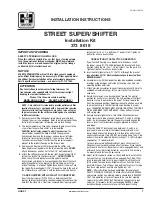
Chevrolet Corvette Owner Manual (Holden-Localizing-Australia/New Zealand-
15749882) - 2022 - CRC - 9/20/21
Driving and Operating
155
Caution (Continued)
and do not overtighten. Hand start the
fasteners to ensure that the threads do
not bind or cross thread.
The racing and competitive driving wheel
alignment settings should be set as
described here.
To achieve the track alignment specified
settings:
1. The upper control arm to body washers
on all four corners will need to be
moved from between the body and the
control arm and relocated between the
head of the bolt and the control arm.
2. Adjust the lower control arm cam bolt
position to achieve the following
specifications.
Front (per corner)
.
Caster: +8.0 degrees
.
Camber: -3.0 degrees
.
Toe (total): 0.1 degrees toe in
Rear (per corner)
.
Caster: 0 degrees
.
Camber: -2.5 degrees
.
Toe (total): 0.1 degrees toe in
.
Thrust Angle: 0 degrees
After track use, reinstall washers between
the body and the control arms. Reset to
factory alignment settings. See your dealer.
If the Vehicle Is Stuck
Slowly and cautiously spin the wheels to
free the vehicle when stuck in sand, mud,
ice, or snow.
If stuck too severely for the traction system
to free the vehicle, turn the traction system
off and use the rocking method. See
Traction Control/Electronic Stability Control
{
Warning
If the vehicle's tyres spin at high speed,
they can explode, and you or others
could be injured. The vehicle can
overheat, causing an engine compartment
fire or other damage. Spin the wheels as
little as possible and avoid going above
56 km/h (35 mph).
Rocking the Vehicle to Get it Out
Turn the steering wheel left and right to
clear the area around the front wheels. Turn
off any traction system. Shift back and forth
between R (Reverse) and a low forward
gear, spinning the wheels as little as
possible. To prevent transmission wear, wait
until the wheels stop spinning before
shifting gears. Release the accelerator pedal
while shifting, and press lightly on the
accelerator pedal when the transmission is
in gear. Slowly spinning the wheels in the
forward and reverse directions causes a
rocking motion that could free the vehicle.
If that does not get the vehicle out after a
few tries, it might need to be towed out.
If the vehicle does need to be towed out,
see
Vehicle Load Limits
It is very important to know how much
weight the vehicle can carry. This
weight is called the vehicle capacity
weight and includes the weight of all
occupants, cargo, and all non-factory
installed options. The Tyre and Loading
Information label may show how much
weight it may carry.
















































